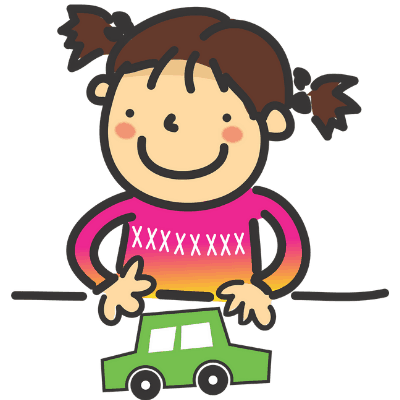
(PDF) 100 Effective Calming Strategies for Kids (or Adults!) + Free Checklist!
Looking for effective calming strategies to help kids (or adults) relax?
Calming strategies for kids are tactics, activities, worksheets, or exercises aimed to help reduce their:
- anxiety
- anger
- overexcitement
- tension
There are lots of activities that can help our kids when they are feeling upset, anxious, or overexcited.
Most of the activities you will read below are also used as calming strategies for adults.
Calm down strategies usually fall in one or more of these categories:
- Relaxation methods
- Learning problem-solving abilities
- Attention diversion from anger triggers or situations
- Self-regulation strategies
- Emotion recognition
- Learning to channel feelings appropriately
- Coping strategies adapted to specific situations
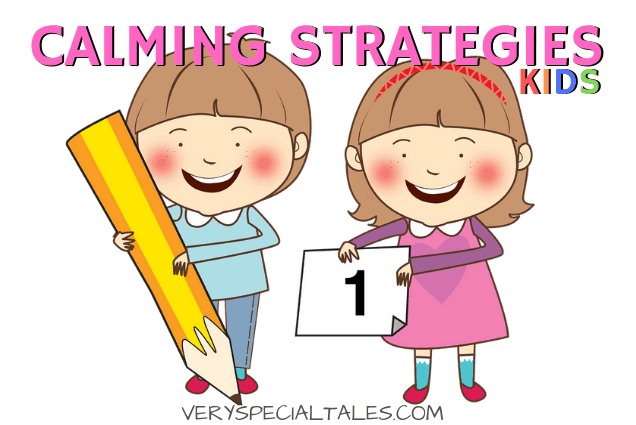
(Disclosure: We are a participant in the Amazon Services LLC Associates Program, an affiliate advertising program designed to provide a means for us to earn fees by linking to Amazon.com and affiliated sites. As an Amazon Associate, I earn from qualifying purchases. There may also be other affiliate links in this post. You can also read our Disclosure & Disclaimer policy here)
100 Useful Calming Strategies for Kids
I would be surprised if you can’t find in this extensive list a good number of strategies that will help your children calm down when they feel worried, frustrated, or angry.
At the end of the post, you will also be able to download our free “100 Calming Strategies for Kids” PDF.
Breathing Exercises for kids
Breathing exercises help control excessive physiological arousal.
These are some examples of exercises that help children learn deep breathing are (we also used these activities when we were working with our speech therapy on strengthening muscles) :
- Ask your child to pretend to smell a flower / pretend to blow a candle
- Blow soap bubbles
- Blow a pinwheel
- Place pieces of cotton on a flat surface and blow on them to move them along.
- Blow a candle
- Deep breathing while Mum/Dad counts to 10
- Belly Breathing (Diaphragmatic breathing)
- Lazy 8 Breathing exercise
- Square Breathing
- Alternate nostril breathing
Place your thumb on your right nostril and your middle and index on your left nostril. Hold your right nostril closed with your thumb and breathe in slowly through the left one. Breathe out through the right nostril while closing the left one. Hold your breath a couple of seconds and breathe in through your right nostril, keeping the left one closed. Continue alternating sides. - Lion’s Breath (Take a deep breath through your nose / Open your mouth as big as you can / Stick your tongue out
Eyes wide opened / ROAR!) - Bumble Bee Breath ( Breathe in / Breathe out with your mouth closed, while you hum like a bee)
➡️ Learn more Yoga Breathing Exercises for Kids
Mindfulness
Kabat-Zinn, probably the most reputable Mindfulness author, describes Mindfulness as “the awareness that arises from paying attention, on purpose, in the present moment and non-judgmentally”
➡️➡️Try Audible for Free HERE
Examples of mindfulness techniques:
- Body Scan Meditation – this meditation technique involves systematically and intentionally moving our attention through our body, attending to the various sensations in the different regions.
- Eating a raisin (or chocolate) mindfully
- Go for a mindfulness walk
- Use grounding rocks or gratitude rocks
- Meditation
- 5-4-3-2-1 Grounding Exercise ( ⬅️ Read the blog post and grab your 54321 grounding poster)
This is a very simple and extremely effective grounding exercise. It will distract your child from the anxiety trigger, help focus on the present moment, and relax.
Ask your child:
Name 5 things you can SEE in the room
Name 4 things you can FEEL
Name 3 things you can HEAR
Name 2 things you can SMELL right now
Name 1 thing you can TASTE.
Yoga as a Relaxation Tool
Yoga has many benefits and can be used as a tool to help us relax (Read my post about the benefits of yoga for kids)
These are some examples of fun calming poses for kids:
- Cat pose
Kneel on all fours and slowly raise your back (arch the spine). Then lower your back - Cow pose
This pose is usually used as a counter-posture to the Cat Pose. Kneel on all fours lift your head and look forward, while your belly moves toward the floor and your back lowers. - Child pose
Kneels and fold your body forward so that your thighs rest on your calves and your head rests on the floor. - Legs up the wall
Extend your legs up the wall and rest your arms by your side. Can it get easier than this? 😊 - Corpse pose
Another easy one!. Lie on the back with your eyes closed and the legs slightly spread. Rest your arms by your side.
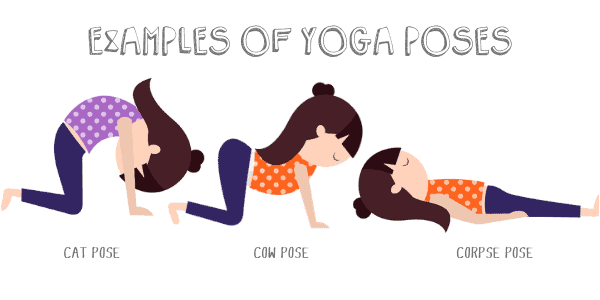
If you may initially feel it’s difficult to engage your child in this great activity, there is a little trick that can get even the most exercise-averse child to try yoga.
Animal yoga poses turn yoga into a fun game.
Check out this set of absolutely gorgeous yoga cards that portray 32 different yoga poses named after different animals.
Muscle Relaxation Techniques & Proprioceptive Input
- Progressive muscle relaxation exercises.
The premise of this relaxation method is that physical relaxation will lead to a feeling of calmness.
In progressive muscle relaxation, you systematically proceed to tense and then relax muscle groups, following a certain order. - Squeeze a stress relief ball with your hand / release it
This follows the same principle as the previous technique. But it may be easier to teach a kid to start with just squeezing a ball.
And, if you are into DYI you can learn how to make homemade stress balls in just 3 minutes! - Hug tight a soft toy
One more tensing-relaxing exercise. You can also teach your kids how to “breathe in /hug tight / breathe out / relax”, repeating this cycle several times till they start feeling calmer - Give yourself a big hug
- Hug your knees
Sit on the floor with your feet planted on the floor, hug your knees tight - Palm Presses- press your palms together, and hold for 5 seconds. Repeat a few times till you feel calmer.
- Hand Squeeze- this is similar to the previous exercise, but you will interlace your fingers and squeeze your hands tightly.
- Wall push- face the wall and place your palms flat on the wall. Push for five seconds.

Calming Massage for Kids
Medical research has shown that the benefits of massage include pain relief, reduced anxiety, and depression, and temporarily reduced blood pressure, heart rate, and state of anxiety.
But even if you don´t know anything about massage, lots of kids find it really soothing to have a soft foot, hand, back, or head massage.
These are some fun massage ideas for kids:
- Foot massage with lotion
- Head massage (we sometimes use essential oils and administer a nice and relaxing head massage before the shower)
- Arm massage – firmly squeeze your arm, start with your shoulder and move all the way down to your shoulder.
- Hand massage- use your thumb to press firmly the palm of your other hand
- Ear massage- gently pull and rub your ear lobes to stimulate the nerve endings and release endorphins.
- Story Massage
➡️ Learn more about massage for kids.
Calming Down through Intense Activity
Use physical activity to burn energy out. This is a distraction strategy that can work really well:
- Bounce-on ball
- Jump / Skip jumping / Jumping Jacks
- Go for a run / Get your child to run around a piece of furniture if you can’t go out
- Go bike riding
- Play catch with a weighted ball
- Dance like there’s no tomorrow!
Using Deep Pressure as a Calming Tool
Many kids find deep pressure touch very calming. These are some examples of items that provide deep pressure input:
- Weighted blankets
⇒ These are a few tips on how to use weighted blankets with kids. - Weighted vests
- A weighted stuffed puppy
- A body sock
- Blanket wrap
Put a blanket on the floor and ask your child to lie down on it. Wrap the blanket around tight enough to give a gently hug (obviously, the head should stick out) - Baby Swaddle Wrap (for those who are not babies anymore!)
This is similar to the previous strategy, and I use it with a big boy, not a baby. Instead of a complete swaddle wrap, I wrap him from waist up with a big towel.
Other Sensory Strategies to Calm Down Kids
- Look at the relaxing motion of a lava lamp
- Use lights to calm your kids down. These items are some examples: a rainbow curtain, night light projector, or electric jelly fish tank.
- Soothing noises, like the ones you hear in nature or in this wave projector
- Use noise-canceling headphones to block noise around you.
- Use your sensory bottles
- Play with a sensory bin.
- An indoor swing (the back and forth movement of a swing is extremely soothing)
- Enjoy the rocking input from a rocking chair.
- Use wiggle cushions. Wiggle cushions are great for kids with ADHD or sensory issues. It provides them with some movement, so it comes very handy when they need to sit down for long periods of time (they may not feel the same urge to stand up and move around)
- Essential Oils
“Change of Scene” Calm Down Ideas
Sometimes it helps to move away from the situation or setting that has triggered the anxiety or upset. Examples of this calm down strategy could be:
- Move to a different room from where the problem is happening
- Step out into the garden
- Go for a walk / Mum/Dad take the child for a walk
- Move to the calm down corner
- Prepare a calm down tent- a physical space where your child can retreat if she needs to move away from the stimuli surrounding her. It is similar to a calm down corner, but you create space within the room.
“Change of Activity” as a Calm Down Strategy
Another calm down strategy is to divert your attention from the issues that are causing the problem. These are some calming ideas:
- Watch a favorite tv program
- Play board games
- Play computer games
- Read a book / Parent reads a story
- Play with playdough
- Listen to music ( ➡️ Amazon Music Unlimited Free Trial)
- Listen to an audiobook (➡️ Try Audible for Free & Get Two Free Audiobooks)
- Sing out loud to release the tension
- Tickle monster! Tickle your child’s worries away!
- Play with fidgeting toys
Related: Learn how to help students focus with fidgeting devices
Art Therapy as a Calming Tool
In art therapy, we use the art process to reflect, express, and discuss feelings and emotions, in order to help us relieve anxiety and develop coping skills. Some of the tools we have already mentioned are also used in art therapy.
- Make a drawing of your day: a creative way to share some things that your kid may not be able to express with words.
- Mandala drawing for kids
- Prepare gratitude stones (I’ve mentioned gratitude rocks before, but in that section, I was focusing on the use as a grounding rock, so I wanted to mention it here again as an art therapy activity).
Using Imagination to Calm Down
- Think about things that make you happy
(We have a “wall of happiness” in each kid’s bedroom. It’s a nice way to use kid’s wall art as a coping skill tool ) - Visualize yourself in your happy place
- Swap bad thought for happy memories
- Write down your worries on a piece of paper and then tear the paper
- Mentally throw away your angry or worry thoughts (pretend you are throwing them out of the window, or into the rubbish bin)
- Put your worries inside a worry box
A “Worry Box” is a place to store away worries until you are ready to deal with them.
When a worry thought strikes, you write it down on a piece of paper and you store it away in your worry box. - Feed your worries to the worry eater
Other Calming Ideas for Kids
- Help them express their feelings with an emotions chart. Being able to express our emotions also helps us soothe and relax.
- Teach your kids problem-solving skills.
You can use the “Stop / Think / Do” technique: Stop when you are very angry / Think about what alternatives you have to solve the problem / Implement the chosen one - Create routines.
- Start counting till you feel more relaxed
- Keep a journal where you write down your feelings.
There a many types of journals.
If your kid is struggling with angry feelings an anger journal may be an incredibly useful tool.
A journal helps record:- thoughts
- feelings
- anger triggers
- anger warning signs
- behavioral responses
Reviewing their journal records can shed some light on:
- the role that thoughts and feelings play
- situations that may need to be avoided
- behaviors they may need to modify
- coping skill that may help them in the future, or
- when they need to start practicing coping strategies
- Practice your positive affirmations (there are also positive affirmations for anxiety)
Affirmations resources:- Anxiety Affirmation Cards for Kids
- Positive Affirmations Cards (cute animals)
- Start the day thinking about 3 things you are grateful for (More Gratitude Ideas for Kids)
- Retell the story.
I use this technique quite often. Sometimes we have situations that we can’t discuss because they lead to frustration, anxiety, or anger. I still want to discuss them because I want our son to reflect on what has happened, so we retell the story as if it had happened to his best friend. I even make drawings as if we were telling a tale. - Self-instruction
Some kids may benefit from using self-instruction to guide them through some difficult situations. It provides them with a script of what needs to be done (What is the problem? What is my plan? How can I do it? …) - Give me a smile.
I sometimes use my own hands to move my son’s lip corners up in a smile. Did you know that even a fake smile can make your brain believe that you are happy? - Talk to somebody you trust
- Ask for help
- Take a warm bath
- Have a snack
- Drink a glass of water or milk
- Make sure your kid is rested and is having enough hours of sleep
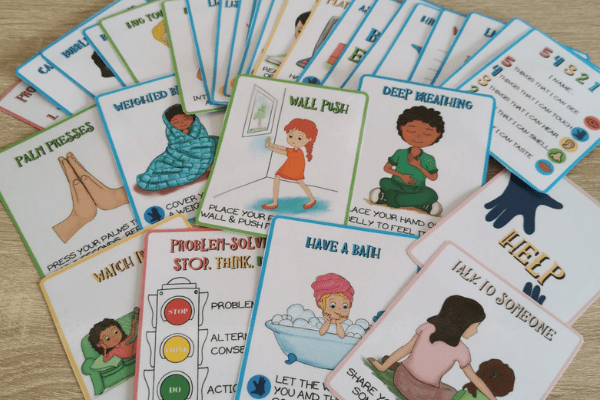
Useful calming tips for kids
Tip 1: it is a great idea to keep all the items that help your kid self-soothe in a place where your child can easily access them. ? Ideas for a calming box
Tip 2: Use calm down strategy cards. Using visuals (calm down cards) when teaching kids to cope with big emotions (anger or anxiety) has many benefits like:
- assisting them to make their choices
- facilitating self-regulation
- supplementing or replacing speech for those kids who can´t communicate verbally
You can download my free calm down cards from here ➡️ anger management activities for kids
100 Effective Calming Strategies for Kids ( Checklist – Free PDF Download)
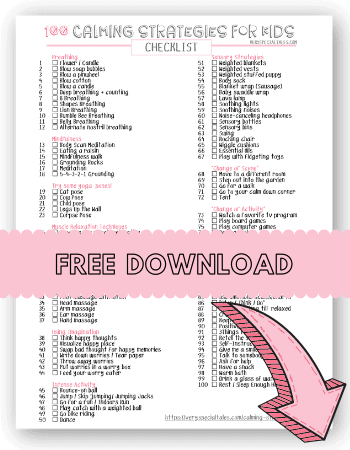
♥SHARE THIS PIN♥⇓
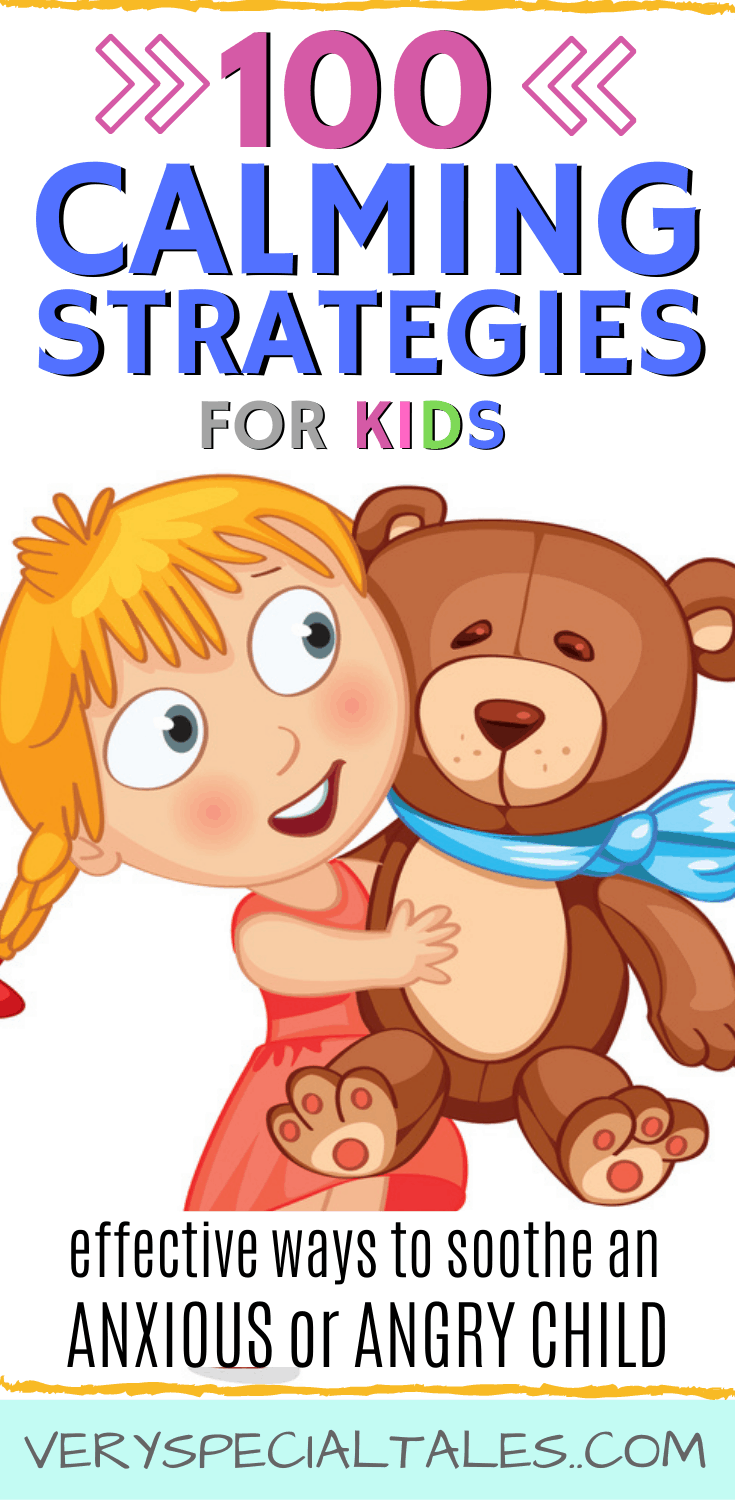


5 Comments
Carol Rogers
For anxiety in kids, mindfulness techniques can increase anxiety. That would include focused breathing, meditation, yga, body scans, depending on the child/adolescent. They are not helpful for all, and can be harmful to some- not to be used in a group.
Clara
Thanks for your input, Carol. You are absolutely right, one of the side effects of these type of techniques is that focusing on their body signals, their own emotions, their internal space may increase anxiety in some people depending on their personality or background stories. So it may not be for everybody, and as you well imply, if you are working with a group you will not be able to closely monitor every person.
Deborah
Thank you!
Anjali
What a comprehensive list! Thank you!!
Clara
Thank you for your kind words and your support, dear Anjali. I am glad to hear that the resources I am providing are helpful, and I look forward to sharing more valuable resources with you in the future.